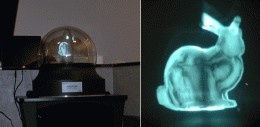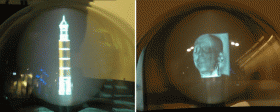December 22, 2008 feature
Improved Volumetric Displays May Lead to 3D Computer Monitors

(PhysOrg.com) -- Volumetric 3D displays have been around for nearly a century, but they face several challenges that have prevented their use in widespread applications. Recently, a team of researchers from the UK and the US have made some significant improvements that may pave the way toward commercializing volumetric displays for 3D viewing.
Volumetric displays involve thousands of 3D pixels (or “voxels” for “volume elements”) that either absorb or emit light from an “isotropically emissive light device” (IEVD). The voxels are projected onto a screen that rotates 24 times per second, creating a 3D image. Because the image is composed of either the presence of absence of light, it creates an X-ray-like effect of the input data. Ideally, the technique could be used for data visualization, such as viewing complex mathematical surfaces, technical designs, and biological and chemical structures, as well as for entertainment purposes.
Researchers Benjamin Mora and Min Chen of Swansea University in Singleton Park, Swansea, UK, along with Ross Maciejewski and David S. Ebert of the Purdue School of Electrical and Computer Engineering in West Lafayette, Indiana, US, have developed a technique that improves the image quality in volumetric 3D displays. Their study will appear in an upcoming issue of IEEE Transactions on Visualization and Computer Graphics.

One of the biggest problems with volumetric displays is the difficulty in portraying shading of object surfaces and displaying opaque objects, both of which are common in real-world situations. To improve these traits, the researchers developed a new technique that modifies the original input data in such a way as to allow the light rays to produce more shading and darkening effects. They call the modified dataset a “lumi-volume.”
The researchers demonstrated that, when they fed the lumi-volume data into the IEVD, the emitted light field and image contained shading effects as good as the shading found in images rendered on a traditional 2D computer screen – an achievement that was once thought to be impossible. The technique could also generate better quality opaque objects.
“Our paper mathematically formalizes the rendering equation/model for these displays, minimizing the difference between the intended 3D output and the actual one,” Mora told PhysOrg.com. “Without such formalization, shading cannot be kept under control. This can be compared with the traditional use of such a display by spatially lighting and coloring the 3D object's surface, which is intuitive from a modeling point of view, but, unfortunately, cannot reproduce proper shading.”
Volumetric 3D displays have several inherent advantages compared with other kinds of 3D displays. For instance, viewers don’t need to wear special glasses, but can still observe the 3D scene from multiple angles and depths. Also, unlike holographic techniques, volumetric displays don’t require extremely large amounts of computation for data processing. And now, the shading effects can capture surface curvature and texture to provide improved image quality.
“3D displays have several advantages when compared to similar techniques,” Mora said. “Stereo techniques need either special glasses or special 3D screens, which may not suit every user. Other more complex 3D devices use multiplex images on a horizontal axis, but not on the vertical axis. This may result in a distorted 3D image if the user is not located at a pre-defined distance from the display.”
Further improvements are still needed before immediately jumping to applications, the researchers said. But they expect that this study will stimulate further research into hardware improvements, increasing the field of view, and reducing transparency effects. They suggest that some of these problems might be solved by projecting two images onto opposite sides of the rotating screen, enabling the use of two different lumi-volumes and better quality renderings.
Eventually, volumetric 3D displays could be easily incorporated into a future computer system as a second monitor. The 3D monitor could have applications in data visualization, medical and military training, and movies and games.
“Virtually any 2D application could eventually be ported to a 3D volumetric display system and then experience some visual improvement,” Mora said. “However, current technology limits prevent these devices from going mainstream. Thus, 3D displays are mainly suitable to domains like entertainment, education, and scientific visualization. For instance, gaming or watching a video on such a display may not yet be ideal due to a lack of power on current processors; however, this technology can already be deployed in museums for showcasing virtual objects. Also, these devices have strong potential for estimating the visual impact of objects (e.g., car design, buildings, etc.) in their environment and the interpretation of complex 3D datasets and medical images, although more user studies there would be needed.”
More information: Mora, Benjamin; Maciejewski, Ross; Chen, Min; and Ebert, David S. “Visualization and Computer Graphics on Isotropically Emissive Volumetric Displays.” IEEE Transactions on Visualization and Computer Graphics. To be published.
Copyright 2008 PhysOrg.com.
All rights reserved. This material may not be published, broadcast, rewritten or redistributed in whole or part without the express written permission of PhysOrg.com.





















